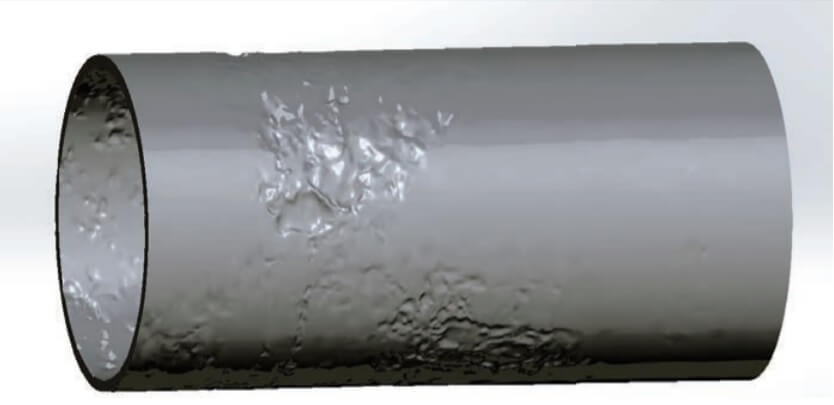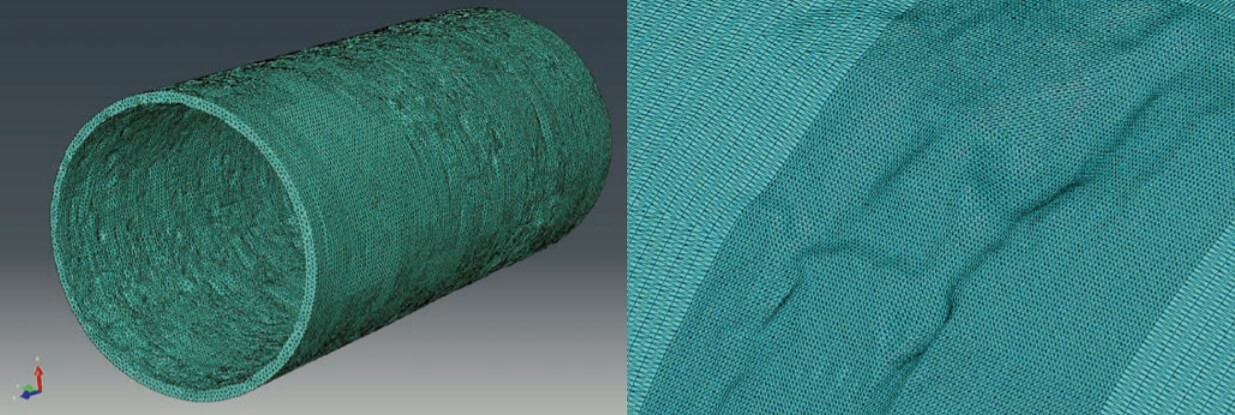Laser scanning (profilometry) is a highly effective and accurate inspection method for measuring changes in geometry of pressurized vessels, piping and pipelines. The laser scanning data is used to measure the deviations from normal geometry, such as those caused by corrosion, mechanical damage and other structural distortions. The primary goal of the laser scanning analysis is to feed highly accurate geometric data of in-service vessels and components into advanced modelling and analysis software packages.
3D Laser Scanning and Corrosion Assessments
Laser scanning enables both internal and external assessment of corrosion, displacement and other forms of structural damage. (Read Using 3D Laser Analysis for Nondestructive Testing and Evaluation of Pipeline Corrosion for more information on this technique.) The laser data is taken and analyzed for geometric deviations that meet or exceed the client’s performance indicators, such as wall thickness loss, pit depth and size, and shape of structural defects. Once a problem area has been identified, the data can then be reverse engineered into a CAD model so that it can be imported for further analysis and for conducting a corrosion assessment.
The three levels of assessment vary in complexity and conservatism, with Level 1 being the least complex and most conservative. Level 2 assessments require more detailed input regarding operating conditions and material properties in order to provide a higher level of analysis. Level 3 assessments are the most advanced, requiring detailed data, computer analysis and a high level of technical knowledge and expertise in fitness-for-service assessment procedures. Once a Level 3 assessment has been carried out on a piece of pressure equipment employing laser scan data in a finite element analysis (FEA), the cost of subsequent assessments is reduced.
Laser scanning is highly advantageous if an assessment doesn’t comply with or pass the Level 2 assessment, for example, when the area of interest is in close proximity to a major structural discontinuity, or the geometry of the component is complicated and difficult to model accurately through finite element analysis. The resultant stress from the model can then be assessed against fitness-for-service acceptability criteria for failure. Laser scanning data allows for a rapid assessment, and therefore a much faster return to service outcome or remediation planning. The natural corollary of this is that overall asset management and safety management is significantly improved.
Laser Scanning Results
The following example (Figure 1) shows laser scanning applied to a pipe suffering from both internal and external corrosion. The pipe was 1320 mm long, with an outer diameter of 635 mm and a thickness of 24 mm. Compared with traditional methods of conducting thickness grid measurements using a thickness gauge, laser scanning provides a more accurate thickness profile and enables future repeatability. The high level of accuracy also means that the level of conservatism employed during an assessment can be minimized, reducing unnecessary repairs and downtime.
Laser scans are compatible with all major FEA and modelling software. The image below illustrates the process of a Level 3 metal loss FEA assessment using a laser-scanned model. In this case, it can be seen that the corrosion profile is captured by the scan (Figure 1). This level of corrosion profile modelling cannot be reasonably achieved through standard techniques.

Figure 1. Solid model constructed from laser scan data.
In the following steps, corresponding material properties, boundary and loading conditions are applied, preceded by the construction of the FEA mesh over the model (Figure 2).

Figure 2. Example of FEA mesh applied to model (left) and refinement around areas of interest (right).
The simulation is then run and stress results extracted. Another advantage of FEA based analysis is that loading and operational parameters can be easily modified, allowing assessment of multiple operational scenarios quickly and easily.
Figure 3 shows an example of the stress results when the pipe is subjected to an internal pressure of 1 MPa. The magnitude and location of the peak stresses can be clearly seen and extracted for use in a Level 3 assessment. Besides metal loss assessments, the results can also be used for a variety of purposes, including but not limited to, evaluation of maximum allowable working pressure, cyclic fatigue analysis, and leak before break analysis. More advanced forms of assessment such as coupled heat transfer-mechanical simulations and modal analysis are also made possible through the use of FEA.

Figure 3. Stress results visualized (left) and detailed view of high stressed location (right).
Conclusion
With micron accuracy precision and reduction of inspection times by a factor of 10 times, laser inspection integrated with modern fitness-for-service and finite element analysis software is a rapid return to service method of analysis.
The integration of laser scanning data with fitness-for-service and remaining life assessment provides more accurate, cost effective and time efficient assessment that is not possible using previously available methods.